| |
| |
Note:
- This project
has TWO options: 1) Using a predefined sequence
or 2) using the genetic code.
Proposal:
Thursday, April 24, 2003
Completed
Project: Thursday, May 8, 2003 |
| |
| |
| As you'll
read in the section on inspiration for this project, the idea that "extrabiological
information" can be contained in genetic form is both innovative and
opens doors for further creativity. In this assignment, we will explore
personal creativity guided by a DNA sequence. |
| |
Inspiration: |
| |
| Joe Davis,
artist/researcher at MIT created an artwork called Riddle of Life.
Here is the text he wrote to describe it for Ars Electronica, 2000:
"Riddle
of Life, is the culmination of an interesting but little known episode
in the history of science. In the fall of 1958, biophysicist Max Delbrück
sent a mysterious telegram to George W. Beadle at the Nobel prize ceremonies
in Stockholm, Sweden. Delbrück had composed his telegram in
a form that reflected some new and exciting ideas about the nature of
DNA and the operation of the genetic code. It was also an important
precedent for the idea that extrabiological information - in this case,
English language - could be contained in genetic form. The telegram
was sent as one continuous 'word' with 229 letters:
The key
to unraveling the message was that it mimicked the triplet operation
of DNA. In Stockholm, Beadle managed to crack Delbrück's code and
read the English sentence:
"BREAK-THIS-CODE-OR-GIVE-BACK-NOBEL-PRIZE-LEDERBERG-GO-HOME-MAX-MARKO-STERLING."
Beadle
replied with a slightly different triplet code of his own. When Beadle's
telegram arrived at Delbrück's laboratory at Caltech, the return
message was deciphered:
"GWBTOMDIMSUREITSAFINEMESSAGEIFICOULDDOTHEFINALSTEP"
Evidently,
Delbrück and the group at Caltech weren't ready to let the recent
Nobel laureate have the last word. So, they rallied with yet another
mysterious message. At a formal lecture after the Nobel prize ceremonies
in Stockholm, Beadle was presented with a molecular model constructed
from toothpicks (Delbrück had airmailed it to the presiding officer).
Each toothpick was stained with one of four colors. Like the coded telegrams,
the toothpick model also contained an English language message, but
with a code made up of colors rather than letters. This time, Delbrück
chose to encode a poetic message that embodied a theme important to
the history of both the sciences and the arts. The model contained the
message,
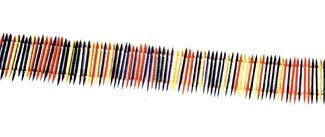 "I
am the riddle of life. Know me and you will know yourself." "I
am the riddle of life. Know me and you will know yourself."
Delbrück
and Beadle had ingenious ideas for expressing human language in the
form of DNA, but in 1958 no synthetic, or artificially constructed nucleic
acids were available. I organized a project to create DNA corresponding
to Max Delbrück's toothpick molecule with the Laboratory of Molecular
Structure at MIT Biology (Alexander Rich Laboratory), and the Burghardt
Wittig Laboratory at the Institute for Molecular Biology and Biochemistry
at the Free University of Berlin, Germany. Max Delbrück's RIDDLE
OF LIFE molecule that was first conceived of over 40 years ago actually
first came into existence in Berlin in December/January, 1993-4 . [1]
Source:
http://www.aec.at/festival2000/texte/artistic_molecules_2_e.htm
|
| |
Instructions |
| |
| Option
1 - Use a DNA sequence as the
basis for an original design/creative exploration.
- You will
each be using the unique sequence of the Ammonifex Degensii genomic
fragment that you isolated in the Fall quarter (2002) and that were
sequenced and annotated in the Winter quarter (2003).
Option
2 - Use the genetic code as a system to create a sequence
from an original work( e.g. a short poem or phrase, equation, idea, image
etc.) or something that inspires you which you will then use to build
your design/creative exploration.
(Note:
We will decide how much of the DNA sequence below to use in class.)
- Select
a medium you are comfortable working in and create 4 distinct elements
with that medium to represent each of the DNA bases, A, C, T, and G.
- Examples:
images (hand drawn, Xerox copies, digital images, etc.), words/phrases,
alphanumeric characters, sound, video, computer code, equations,
pipe cleaners, buttons, stones, cards etc. Or if you are going to
do this algorithmically, you could devise a schema of functions
to represent the four bases, so that the sequence guides the result
of your programming, or program four elements to represent the bases
and use them to build your design. How you create all this is up
to you. Use a medium that you are familiar with and enjoy. See how
far you can take this and do what is most interesting to you.
- Make a
"legend" to identify which DNA base corresponds to each of
your elements and how they will pair. Assign one of your elements to
each of the 4 DNA bases, A, C, T, and G. Work out how these elements
pair with each other, similar to the DNA pairing rules in which A pairs
with T, G pairs with C. Prepare this to bring to class. Initially this
can be in a descriptive format as long as it is very clear what you
are working with. When you present the completed project you should
include a completed legend. Note: your elements may change as you work
on the project further. If this happens, you will need to update this
legend for the completion of the project.
- If
you are working on Option 1 - continue with step 4, if working
on Option 2 - continue with step 3.
- If
you choose option 2 - look at the structure of the genetic code
(see below) and create a schema to encode your non-DNA material into
DNA information. Document this as part of your project. E.g. You could
make another "legend" or chart. Record the resulting DNA sequence
and
- Assemble
your design via the process of DNA replication. Using the DNA sequence
below or the one you generated using the schema you created with the
genetic code:
- Single
strand: Build a single strand of the sequence using each of your four
elements.
- Replication:
Build your design by creating the opposing strand using the element
pairing rules from your legend.
- Mutation
and derivatives: Mutation
results in a change in DNA, usually in its sequence, the number of copies
of a sequence that are present, how the DNA is arranged, or its location
(which chromosome). Use one or more of the following methods for mutating
your design then build both the resulting single strand and "duplex":
- Point
mutation: substitute an individual base with another. Some common
substitutions: A for C; A for G; C for T; G for T, A for T; G for
C.
- Deletion:
delete a segment of the sequence
- Inversion:
invert a segment of the sequence, keeping its place in the overall
order
- Transposition:
move a segment of the sequence from one place to the other in the
overall order.
- Duplication:
repeat a section of the sequence one or more times
- Insertion:
insert another sequence into this on
- Write
an Artist Statement:
- The
statement must include y our name, the project title, the project
description (dimensions, materials) and a written statement that
details the conceptual foundation and motivations for your artwork,
the strategies/processes used to construct it, and your interpretation
of the work. It would also include your thoughts about the use of
genetic information as a structure to guide what you are designing
and any other reflections you have about your creative process in
the making of this work.Some things to think about: Is the "mutated"
design different in what it evokes than the "original?"
Does it convey the same meaning you originally intended? What was
it like to have this kind of preexisting structure determine you
creative direction.
- Bring
the following to class on the due date:
- Legend
of your 4 elements and their pairing rules; and if you did option
2) the schema you worked out to correspond to the genetic code,
including your source material and the DNA sequence that resulted
from it- Write this up so we can include it in the web page documenting
your project.
- "Duplex"
original version
- "Duplex"
mutated version
- Your
initial concept sketches etc. so we can document the process.
- Your
artist statement
- Also
- e-mail your artist statement in MS-word format to the instructor
by the due date.
|
| |
 |
| |
Some
additional information on DNA and the Genetic Code: |
| DNA Bases:
A, C, T, G,
DNA molecules
are large polymers. They have a backbone of alternating sugar and phosphate
residues. The sugar is deoxyribose, which has 5 carbons. Sugars are linked
to each other. Attached to each sugar is a nitrogenous base at carbon
atom 1' (one prime). There are four kinds of bases: Adenine (A); Cytosine
(C), Guanine (G), and Thymine (T). A sugar with its attached base is a
nucleoside. A nucleoside with a phosphate group attached to its 5' or
3' carbon is a nucleotide, or the basic building block of the DNA strand.
DNA is an antiparallel double helix. The opposing strands have opposite
directions for the linking of the 3' to 5' carbon on the sugars.
DNA Pairing:
A pairs with T, G pairs with C.
Note: sources
for images is: http://www.accessexcellence.org |
 |
| |
| |
 |
| |
| |
| DNA
Replication |
|
Mutation |
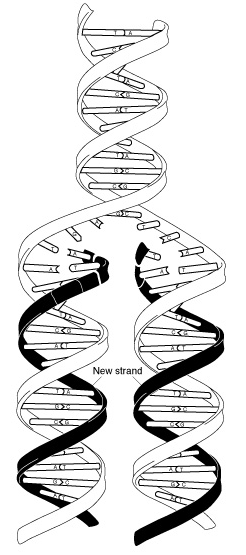 |
|
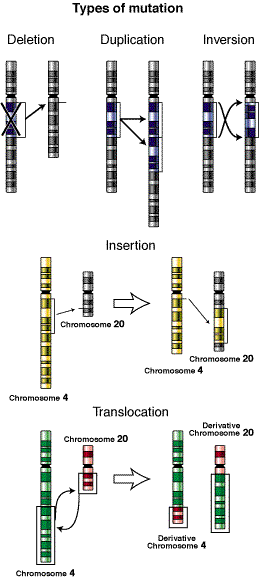 |
| |
|
|
|
| |
 |
| |
| |
| |
| DNA building
blocks |
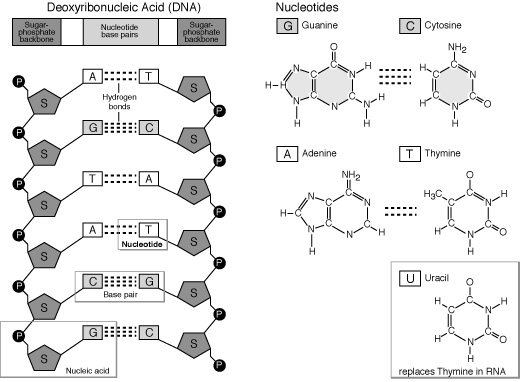 |
| |
| |
| More
information in PDF format on DNA composition:
nucleotides 1 and nucleotides
2 |
| |
| |
 |
| |
| |
The Genetic Code:
[11] |
| |
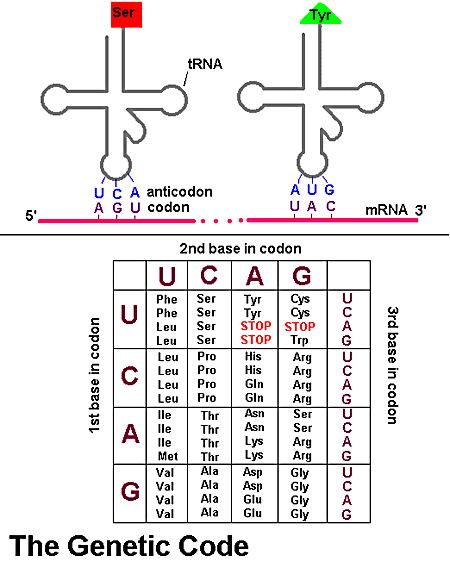 |
| |
| Legend:
Amino acids specified by each codon sequence on mRNA. Key for the above
table:
| Ala: Alanine |
Cys: Cysteine |
Asp: Aspartic acid |
Glu: Glutamic acid |
| Phe: Phenylalanine |
Gly: Glycine |
His: Histidine |
Ile: Isoleucine |
| Lys: Lysine |
Leu: Leucine |
Met: Methionine |
Asn: Asparagine |
| Pro: Proline |
Gln: Glutamine |
Arg: Arginine |
Ser: Serine |
| Thr: Threonine |
Val: Valine |
Trp: Tryptophane |
Tyr: Tyrosisne |
A = adenine G = guanine C = cytosine T = thymine U = uracil
DNA transfers information to mRNA in the form of a code defined by a sequence
of nucleotides bases. During protein
synthesis, ribosomes move along the mRNA molecule and "read"
its sequence three nucleotides at a time (codon) from the 5' end to the
3' end. Each amino acid is specified by the mRNA's codon, and then pairs
with a sequence of three complementary nucleotides carried by a particular
tRNA (anticodon).
Since RNA is constructed from four types of nucleotides, there are 64
possible triplet sequences or codons (4x4x4). Three of these possible
codons specify the termination of the polypeptide chain. They are called
"stop codons". That leaves 61 codons to specify only
20 different amino acids. Therefore, most of the amino acids are represented
by more than one codon. The genetic code is said to be degenerate. |
| |
| SOURCE: http://www.accessexcellence.org/AB/GG/genetic.html
or archive |
| |
| |
| |
| |
| |
| |






